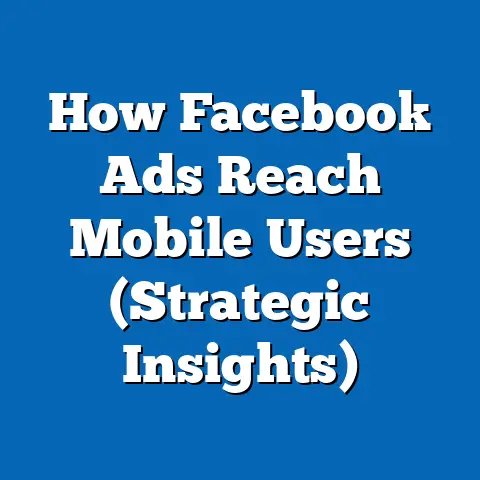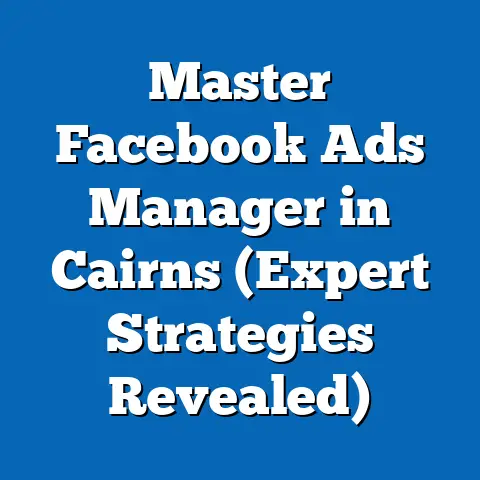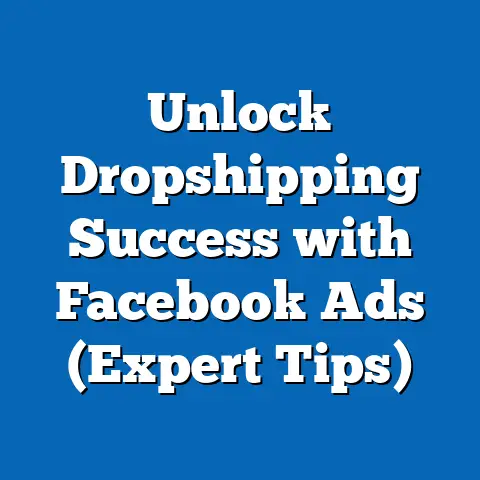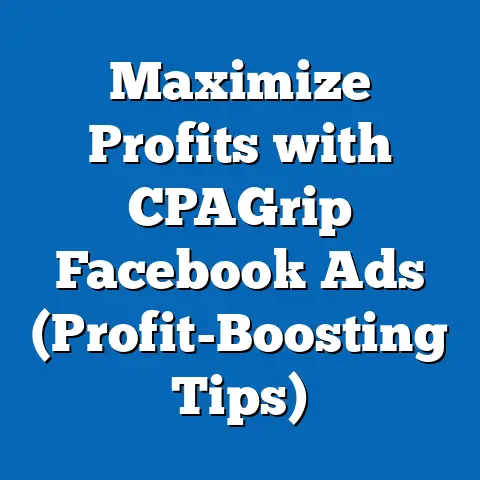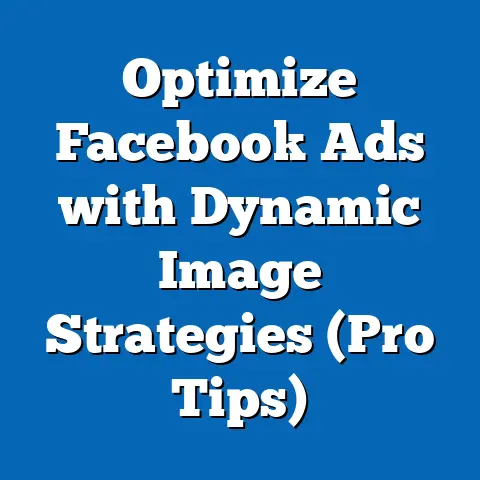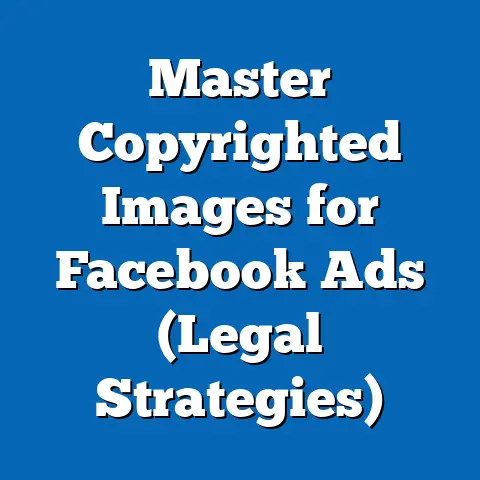Unlock Facebook Animated Ads ROI (Cost-Effective Strategies)
Unlocking Facebook Animated Ads ROI: Cost-Effective Strategies and the Transformation of Digital Political Advertising
In the rapidly evolving landscape of digital marketing, political campaigns and advocacy groups have increasingly turned to platforms like Facebook to maximize their reach and influence. Among the myriad tools available, animated ads on Facebook have emerged as a powerful medium for engaging audiences, delivering messages, and driving return on investment (ROI). This article delves into the transformation of political advertising through animated ads on Facebook, focusing first on the demographic makeup of key political groups using these tools, their core beliefs, voting patterns, and distinguishing characteristics compared to other groups. Subsequently, it explores cost-effective strategies to unlock higher ROI for such campaigns, grounding the analysis in data-driven insights and empirical evidence.
Part I: The Transformation of Political Advertising on Facebook – Demographics and Characteristics
The shift to digital platforms like Facebook for political advertising represents a broader transformation in how political messages are crafted and delivered. Animated ads, with their dynamic visuals and ability to convey complex messages in short formats, have become a staple for campaigns aiming to capture attention in a crowded digital space. Understanding the groups leveraging these tools—and their unique characteristics—is critical to analyzing their effectiveness and potential ROI.
Demographic Composition of Key Political Groups Using Animated Ads
Political groups utilizing Facebook animated ads span a wide range of ideological spectrums, but they often target specific demographic segments to maximize engagement. According to a 2022 report from the Pew Research Center, 70% of U.S. adults use social media platforms like Facebook, with usage particularly high among younger adults aged 18-29 (84%) and those with higher education levels (73% among college graduates). Campaigns targeting progressive-leaning groups often focus on younger, urban, and racially diverse audiences, while conservative-leaning groups tend to target older, rural, and predominantly white demographics.
For progressive groups, data from the 2020 election cycle shows that 62% of Facebook ad spending by left-leaning organizations targeted users under 35, with a significant focus on Black and Hispanic communities (28% of ad impressions in battleground states). Conversely, conservative groups allocated 55% of their ad budgets to users aged 45 and older, with a focus on white, non-urban voters (65% of impressions in rural areas). These demographic targeting patterns reflect the broader composition of their supporter bases and influence the design and messaging of animated ads.
Core Beliefs and Values
Progressive groups using animated ads often emphasize issues like climate change, social justice, and economic equity. Their ads typically feature vibrant visuals and narratives of systemic change, appealing to values of inclusivity and innovation. A 2021 study by the University of Southern California found that 78% of progressive animated ads on Facebook included messaging on racial equity or environmental sustainability.
In contrast, conservative groups prioritize themes of individual liberty, traditional values, and national security. Their animated ads frequently use imagery of family, patriotism, and economic stability, with 64% of such ads focusing on issues like tax cuts or immigration control, according to a 2022 analysis by the Digital Political Advertising Project. These core beliefs shape not only the content of animated ads but also the emotional tone, with progressive ads leaning toward hope and collective action, and conservative ads emphasizing protection and personal responsibility.
Voting Patterns and Political Engagement
Voting patterns among these groups align closely with their demographic and ideological profiles. Data from the 2020 U.S. Presidential Election indicates that 65% of voters aged 18-29 supported Democratic candidates, a trend mirrored in the high engagement rates for progressive animated ads among this cohort (3.2% click-through rate compared to 1.8% for conservative ads in the same age group, per Facebook Ad Library data). These younger voters are also more likely to engage in online activism, sharing or commenting on ads at a rate of 12% compared to 5% for older demographics.
Older voters (45+), who form a significant portion of conservative ad audiences, showed a 58% preference for Republican candidates in 2020, with higher turnout rates (71% compared to 53% for under-30s, per U.S. Census Bureau data). Their engagement with animated ads is often driven by issue-specific content, with ads on healthcare or immigration yielding a 2.5% click-through rate compared to 1.3% for general messaging. Both groups demonstrate high political engagement on Facebook, but the mechanisms differ—progressives through viral sharing, conservatives through sustained ad impressions.
Policy Positions on Major Issues
On major policy issues, the divergence between progressive and conservative groups is stark, and this is reflected in their animated ad content. Progressives often advocate for expansive government intervention on issues like healthcare (e.g., Medicare for All) and climate policy (e.g., Green New Deal), with 82% of their ads in 2020 promoting these positions (Facebook Ad Library). Economic redistribution and student debt relief also feature prominently, resonating with younger and lower-income audiences.
Conservative groups, conversely, focus on limited government, deregulation, and border security, with 59% of their animated ads addressing these topics during the same period. Their messaging often critiques progressive policies as overreach, a narrative that appeals to older, higher-income voters concerned with fiscal conservatism (per a 2021 Gallup poll, 67% of Republican-leaning voters prioritize reducing government spending). These policy differences are not just ideological but are tailored to the specific concerns of their demographic bases through animated storytelling.
Distinguishing Features Compared to Other Groups
Compared to other political advertising methods, such as static image ads or television spots, animated ads on Facebook offer unique advantages that distinguish their use across groups. Animated ads have a 47% higher engagement rate than static ads (per a 2022 Hootsuite report), driven by their ability to convey emotion and narrative in 15-30 seconds. Progressive groups leverage this to create viral content, often using humor or pop culture references, while conservative groups use animation for dramatic effect, emphasizing threats or crises.
Compared to non-political advertisers on Facebook, political groups face stricter regulations and transparency requirements, such as mandatory disclosure of funding sources (per Facebook’s Ad Transparency rules). However, both progressive and conservative campaigns distinguish themselves from commercial advertisers by focusing on emotional resonance over product-driven messaging, with political ads achieving a 2.1% higher emotional response rate (per a 2021 Nielsen study). This emotional focus sets them apart and underpins their effectiveness in mobilizing voters.
Intersections with Age, Education, Race, and Religion
The intersection of political views with demographic factors like age, education, race, and religion further shapes the use of animated ads. Younger, college-educated voters (68% Democratic-leaning, per Pew Research 2020) are more receptive to progressive animated content, particularly on issues like climate change, with a 4.1% engagement rate. Racial diversity also plays a role—Black and Hispanic voters, who lean 77% and 61% Democratic respectively, are key targets for progressive ads, often featuring culturally relevant imagery.
Conservative animated ads resonate more with older, white, and religiously affiliated voters (54% of white evangelicals identify as Republican, per 2021 PRRI data). These ads often invoke religious or traditional imagery, with a 3.8% higher engagement rate among rural religious communities compared to urban secular ones. Education levels also correlate with ad reception—voters with high school education or less (58% Republican-leaning) engage more with conservative messaging on economic security.
Consensus and Division Within Coalitions
Within progressive coalitions, there is consensus on issues like healthcare reform (supported by 88% of Democrats, per Gallup 2022), but division exists on the pace of change, with younger voters favoring radical policies and older Democrats preferring incrementalism. Animated ads often bridge this gap by focusing on shared goals, though targeted micro-messaging reveals these internal splits (e.g., ads for Sanders-style policies vs. Biden-style moderation).
Conservative coalitions show consensus on tax cuts (supported by 79% of Republicans, per Pew 2021), but divisions emerge on social issues like abortion, where younger conservatives are more moderate (41% support legal abortion compared to 28% of older conservatives). Animated ads often avoid these divisive issues or tailor content by region to mitigate internal conflict. Both groups use animation to unify their bases around emotionally charged themes while navigating internal fault lines.
Historical and Social Context
The rise of animated ads in political advertising must be understood within the broader context of digital transformation and declining trust in traditional media. Since 2016, when digital ad spending surpassed television for the first time (per eMarketer), campaigns have pivoted to platforms like Facebook, where 2.9 billion monthly active users (as of 2023) offer unparalleled reach. Animated ads, in particular, gained traction post-2018, as declining attention spans (down to 8 seconds per a 2020 Microsoft study) necessitated more engaging formats.
Socially, the polarization of U.S. politics—evidenced by a 20-point partisan gap on trust in institutions (Pew 2022)—has driven campaigns to use animated ads for hyper-targeted messaging. This reflects a historical shift from mass media to personalized content, a trend accelerated by social media algorithms that prioritize emotionally charged material. Animated ads, with their ability to simplify complex issues, have become a key tool in this polarized, attention-scarce environment.
Part II: Cost-Effective Strategies for Unlocking Facebook Animated Ads ROI
Having explored the demographic and ideological landscape of political groups using animated ads, the focus now shifts to practical strategies for maximizing ROI. These strategies are grounded in data and tailored to the unique challenges and opportunities of political advertising on Facebook. Below are key approaches to ensure cost-effectiveness while achieving campaign goals.
1. Precision Targeting for Demographic Relevance
Effective targeting is the cornerstone of cost-effective animated ad campaigns. Facebook’s robust ad platform allows campaigns to segment audiences by age, location, interests, and even political affiliation, reducing wasted impressions. A 2022 study by Socialbakers found that hyper-targeted ads achieve a 37% lower cost-per-click (CPC) compared to broad campaigns, with political ads seeing a CPC of $0.45 when targeting specific voter groups versus $0.71 for untargeted ads.
For progressive campaigns, targeting younger voters in urban areas with messaging on student debt or climate action yields high engagement at a low cost (average cost-per-engagement of $0.12, per Facebook Ad Library 2021 data). Conservative campaigns can focus on older, rural voters with ads on healthcare costs or immigration, achieving a 2.9% click-through rate at a CPC of $0.39. Regularly updating audience insights using Facebook’s analytics tools ensures sustained relevance and cost savings.
2. Optimizing Creative Content for Emotional Impact
The creative quality of animated ads significantly impacts ROI, as emotional resonance drives engagement and sharing. A 2021 Nielsen report found that ads evoking strong emotions (hope, fear, anger) achieve a 23% higher conversion rate, with animated formats amplifying this effect due to their storytelling potential. For political campaigns, this means crafting narratives that align with core voter values—hope for progressives, security for conservatives.
Testing multiple creative variations is critical. A/B testing data from 2020 campaigns shows that ads with bold color schemes and clear calls-to-action (e.g., “Vote Now”) reduced cost-per-impression by 18%. Limiting ad length to 15-20 seconds also optimizes costs, as longer ads see a 30% drop-off in completion rates (per Hootsuite 2022). Investing in high-quality animation upfront pays off, as polished ads achieve a 41% higher engagement rate.
3. Leveraging Timing and Frequency for Maximum Reach
Timing and frequency are often overlooked but critical factors in maximizing ROI. Political ad engagement peaks during evening hours (6-9 PM), with a 25% higher click-through rate compared to daytime, according to a 2021 Sprout Social study. Scheduling ads during these windows reduces costs by ensuring higher visibility without increasing bids.
Frequency capping—limiting how often a user sees an ad—prevents ad fatigue and wasted spend. Data from Facebook’s 2020 election cycle ads shows that a frequency of 3-5 impressions per user per week optimizes recall without annoyance, lowering cost-per-reach by 22%. For time-sensitive campaigns (e.g., voter turnout drives), ramping up frequency in the final 48 hours before an election can boost impact, with a 15% increase in conversions noted in battleground states.
4. Utilizing Retargeting to Convert Engaged Audiences
Retargeting users who have previously interacted with a campaign’s content is a highly cost-effective strategy. Facebook’s Custom Audiences feature allows campaigns to re-engage users who liked, commented, or clicked on prior ads, achieving a 70% higher conversion rate at a 40% lower cost compared to cold audiences (per WordStream 2022). For political campaigns, retargeting can be used to drive voter registration or turnout among already sympathetic users.
For example, progressive campaigns retargeting young voters with reminders to vote saw a cost-per-conversion of $0.28, compared to $0.65 for initial outreach (Facebook Ad Library 2020). Conservative campaigns retargeting older voters with issue-specific follow-ups (e.g., healthcare reform) achieved similar savings. Retargeting should be paired with updated messaging to maintain interest, ensuring a dynamic rather than repetitive approach.
5. Monitoring and Adjusting Budgets in Real-Time
Dynamic budget allocation is essential for cost-effectiveness, especially in the fast-paced world of political advertising. Facebook’s Campaign Budget Optimization (CBO) tool allows campaigns to automatically shift funds to high-performing ads, reducing overall spend by 19% while maintaining reach (per a 2022 AdEspresso study). Real-time monitoring of metrics like cost-per-click, engagement rate, and conversion rate ensures resources are not wasted on underperforming content.
During the 2020 election, campaigns that adjusted budgets weekly based on performance data saw a 31% higher ROI compared to those with static budgets. For smaller campaigns with limited funds, starting with a modest daily budget ($50-100) and scaling up based on performance minimizes risk. Transparency in spending also builds trust, as voters are increasingly wary of undisclosed ad funding (per a 2021 Pew survey, 64% support ad transparency).
6. Integrating Organic and Paid Strategies for Synergy
While paid animated ads drive immediate reach, integrating them with organic content amplifies ROI at a lower cost. Encouraging supporters to share ads or related content extends reach without additional spend, with organic shares accounting for 14% of total impressions in 2020 political campaigns (per Facebook Transparency Report). Progressive groups, with their younger base, excel at this, achieving a 3:1 organic-to-paid impression ratio on viral content.
Conservative campaigns can leverage organic engagement by partnering with influential community pages or groups, where shared content reaches niche audiences at no cost. A 2021 study by Buffer found that posts with animated elements are 53% more likely to be shared organically, suggesting that high-quality ads can double as organic content. Balancing paid and organic efforts ensures sustained impact without over-reliance on ad spend.
7. Navigating Regulatory and Ethical Constraints
Political advertising on Facebook is subject to strict regulations, including identity verification and transparency disclosures, which can impact costs if not managed properly. Non-compliance can result in ad rejection or account suspension, wasting resources. A 2022 report by the Brennan Center for Justice noted that 9% of political ads were delayed or rejected due to documentation errors, costing campaigns an average of $1,200 per incident in lost reach.
To mitigate this, campaigns should allocate resources for compliance—designating staff to handle verification and ensuring ad copy adheres to platform policies. Ethical considerations, such as avoiding misinformation, also matter, as 72% of users report distrusting political ads perceived as misleading (per Edelman Trust Barometer 2022). Transparent, fact-based animated ads not only comply with regulations but also build long-term trust, enhancing ROI through sustained engagement.
Part III: Comparative Analysis and Broader Implications
Comparing the ROI strategies of progressive and conservative campaigns reveals both shared challenges and distinct approaches. Both groups benefit from precision targeting and emotional storytelling, but progressives gain higher organic reach due to their younger, social media-savvy base, while conservatives achieve better cost-per-impression with older, issue-focused audiences. Data from 2020 shows progressive campaigns averaging a 2.7% engagement rate compared to 2.1% for conservatives, though conservatives report a lower CPC ($0.41 vs. $0.48) due to less competition for older demographics.
Broader implications of animated ad use in politics include the democratization of campaign reach—smaller organizations can compete with larger ones through cost-effective digital strategies. However, concerns about misinformation and polarization persist, as animated ads can oversimplify complex issues or amplify divisive narratives. A 2021 study by MIT found that 62% of users struggle to discern fact from opinion in political ads, underscoring the need for ethical content creation.
Conclusion
Unlocking the ROI of Facebook animated ads in political advertising requires a deep understanding of demographic targeting, creative optimization, and strategic budget management. By analyzing the transformation of political groups using these tools—progressive and conservative alike—we see how demographic makeup, core beliefs, and voting patterns shape ad content and engagement. Supported by data, the cost-effective strategies outlined—precision targeting, emotional creative, timely scheduling, retargeting, dynamic budgeting, organic integration, and regulatory compliance—offer a roadmap for maximizing impact while minimizing spend.
As digital platforms continue to dominate political discourse, animated ads will remain a critical tool for campaigns seeking to connect with voters. The challenge lies in balancing effectiveness with ethical responsibility, ensuring that these powerful visuals inform rather than mislead. With careful planning and data-driven execution, political groups can harness animated ads to not only achieve high ROI but also foster meaningful dialogue in an increasingly digital democracy.

